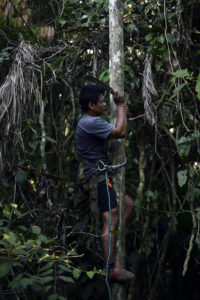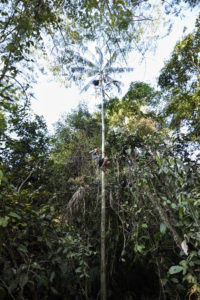Açaí Safety Harnesses Facilitate Harvesting and Save Lives
May 21, 2018
Promoting forest-friendly livelihoods that are safer, more profitable, and encourage conservation
 We have been working with the açaí and Brazil nut harvesters, who depend on the Santa Rosa de Abuná conservation area for their livelihood, to improve how they locate, gather, and process the forest goods they sustainably harvest. This is a key conservation and community development strategy for providing local people with the incentive to keep forests standing, as many of the globally in-demand fruits and nuts they harvest can only grow in healthy forests – not in large-scale plantations. With this strategy in mind, we help families improve their income by growing their local economies through instituting ecologically sustainable activities that protect the forests they call home.
We have been working with the açaí and Brazil nut harvesters, who depend on the Santa Rosa de Abuná conservation area for their livelihood, to improve how they locate, gather, and process the forest goods they sustainably harvest. This is a key conservation and community development strategy for providing local people with the incentive to keep forests standing, as many of the globally in-demand fruits and nuts they harvest can only grow in healthy forests – not in large-scale plantations. With this strategy in mind, we help families improve their income by growing their local economies through instituting ecologically sustainable activities that protect the forests they call home.
Açaí harvesters usually climb 10-15 açaí trees a day with heights reaching up to 65 feet to bring down bundles of açaí weighing dozens of pounds – a tiring and dangerous activity. In 2017, we worked hand-in-hand with community members to design and test prototypes of a safety harness that would meet their needs in the field. This year, we built on their experiences from the previous year’s harvest season and improved the design and features of the harnesses. We distributed 90 new climbing safety harnesses to harvesters in five communities of Santa Rosa. The beneficiaries were enthusiastic because the harness is much safer and more efficient to use. All of the harvesters were trained in how to use the equipment and began utilizing them immediately in the current harvesting season.
 The new harnesses have already proved their value. One of the açaí harvesters, Omar Espinoza, used the new harness to climb a 50-foot high açaí tree, which he does on a daily basis during the harvest season in order to collect the fruit that generates almost all of his family’s income. Due to a misstep coming down the tree with a heavy branch of açaí in hand, Omar fell from a height of about 40 feet, head first. Thanks to one of the features in our safety harnesses – aptly called a “life line” – he was stopped from hitting the ground and just dangled from the harness instead. His head was just a few feet from the ground. Using the harness he had before this project would have meant a certain fall. Had it not been for this new equipment, he would have faced severe and debilitating injuries or possibly, death.
The new harnesses have already proved their value. One of the açaí harvesters, Omar Espinoza, used the new harness to climb a 50-foot high açaí tree, which he does on a daily basis during the harvest season in order to collect the fruit that generates almost all of his family’s income. Due to a misstep coming down the tree with a heavy branch of açaí in hand, Omar fell from a height of about 40 feet, head first. Thanks to one of the features in our safety harnesses – aptly called a “life line” – he was stopped from hitting the ground and just dangled from the harness instead. His head was just a few feet from the ground. Using the harness he had before this project would have meant a certain fall. Had it not been for this new equipment, he would have faced severe and debilitating injuries or possibly, death.
“This is a dangerous job, and there have been many accidents,” Tomás Espinoza, Omar’s dad, says. “No one knows it but us. At times we feel like we have been forgotten by the rest of the country. It’s good to have the support of [Amazon Conservation].”
Omar climbing an açaí trip using the new safety harness. The striped lifeline saved his life once already.

